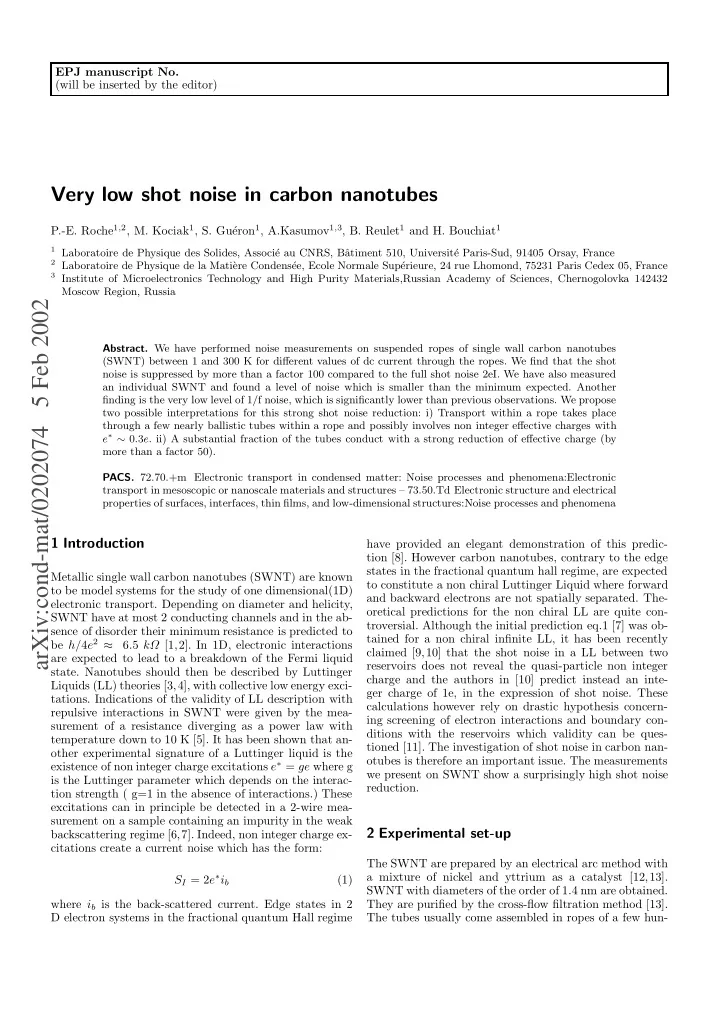

EPJ manuscript No. (will be inserted by the editor) Very low shot noise in carbon nanotubes eron 1 , A.Kasumov 1 , 3 , B. Reulet 1 and H. Bouchiat 1 P.-E. Roche 1 , 2 , M. Kociak 1 , S. Gu´ 1 Laboratoire de Physique des Solides, Associ´ e au CNRS, Bˆ atiment 510, Universit´ e Paris-Sud, 91405 Orsay, France 2 Laboratoire de Physique de la Mati` ere Condens´ ee, Ecole Normale Sup´ erieure, 24 rue Lhomond, 75231 Paris Cedex 05, France 3 Institute of Microelectronics Technology and High Purity Materials,Russian Academy of Sciences, Chernogolovka 142432 Moscow Region, Russia arXiv:cond-mat/0202074 5 Feb 2002 Abstract. We have performed noise measurements on suspended ropes of single wall carbon nanotubes (SWNT) between 1 and 300 K for different values of dc current through the ropes. We find that the shot noise is suppressed by more than a factor 100 compared to the full shot noise 2eI. We have also measured an individual SWNT and found a level of noise which is smaller than the minimum expected. Another finding is the very low level of 1/f noise, which is significantly lower than previous observations. We propose two possible interpretations for this strong shot noise reduction: i) Transport within a rope takes place through a few nearly ballistic tubes within a rope and possibly involves non integer effective charges with e ∗ ∼ 0 . 3 e . ii) A substantial fraction of the tubes conduct with a strong reduction of effective charge (by more than a factor 50). PACS. 72.70.+m Electronic transport in condensed matter: Noise processes and phenomena:Electronic transport in mesoscopic or nanoscale materials and structures – 73.50.Td Electronic structure and electrical properties of surfaces, interfaces, thin films, and low-dimensional structures:Noise processes and phenomena 1 Introduction have provided an elegant demonstration of this predic- tion [8]. However carbon nanotubes, contrary to the edge states in the fractional quantum hall regime, are expected Metallic single wall carbon nanotubes (SWNT) are known to constitute a non chiral Luttinger Liquid where forward to be model systems for the study of one dimensional(1D) and backward electrons are not spatially separated. The- electronic transport. Depending on diameter and helicity, oretical predictions for the non chiral LL are quite con- SWNT have at most 2 conducting channels and in the ab- troversial. Although the initial prediction eq.1 [7] was ob- sence of disorder their minimum resistance is predicted to tained for a non chiral infinite LL, it has been recently be h/ 4 e 2 ≈ 6 . 5 kΩ [1,2]. In 1D, electronic interactions claimed [9,10] that the shot noise in a LL between two are expected to lead to a breakdown of the Fermi liquid reservoirs does not reveal the quasi-particle non integer state. Nanotubes should then be described by Luttinger charge and the authors in [10] predict instead an inte- Liquids (LL) theories [3,4], with collective low energy exci- ger charge of 1e, in the expression of shot noise. These tations. Indications of the validity of LL description with calculations however rely on drastic hypothesis concern- repulsive interactions in SWNT were given by the mea- ing screening of electron interactions and boundary con- surement of a resistance diverging as a power law with ditions with the reservoirs which validity can be ques- temperature down to 10 K [5]. It has been shown that an- tioned [11]. The investigation of shot noise in carbon nan- other experimental signature of a Luttinger liquid is the otubes is therefore an important issue. The measurements existence of non integer charge excitations e ∗ = ge where g we present on SWNT show a surprisingly high shot noise is the Luttinger parameter which depends on the interac- reduction. tion strength ( g=1 in the absence of interactions.) These excitations can in principle be detected in a 2-wire mea- surement on a sample containing an impurity in the weak 2 Experimental set-up backscattering regime [6,7]. Indeed, non integer charge ex- citations create a current noise which has the form: The SWNT are prepared by an electrical arc method with a mixture of nickel and yttrium as a catalyst [12,13]. S I = 2 e ∗ i b (1) SWNT with diameters of the order of 1.4 nm are obtained. where i b is the back-scattered current. Edge states in 2 They are purified by the cross-flow filtration method [13]. D electron systems in the fractional quantum Hall regime The tubes usually come assembled in ropes of a few hun-
Recommend
More recommend